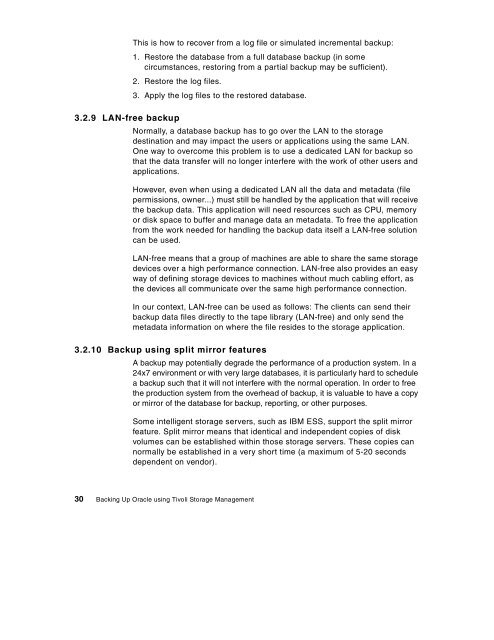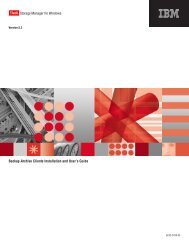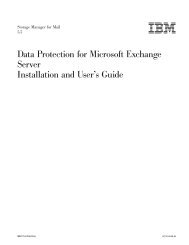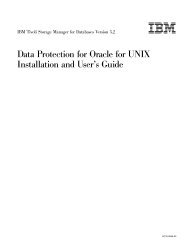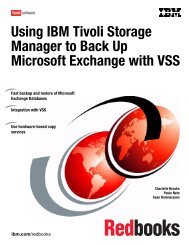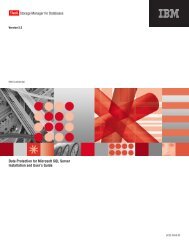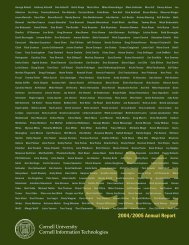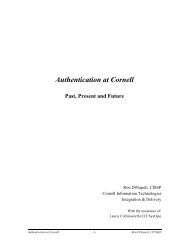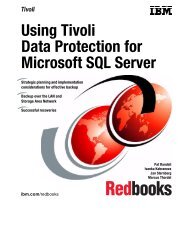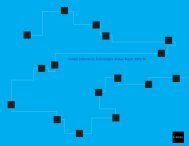Backing Up Oracle - Computing at Cornell
Backing Up Oracle - Computing at Cornell
Backing Up Oracle - Computing at Cornell
Create successful ePaper yourself
Turn your PDF publications into a flip-book with our unique Google optimized e-Paper software.
This is how to recover from a log file or simul<strong>at</strong>ed incremental backup:<br />
1. Restore the d<strong>at</strong>abase from a full d<strong>at</strong>abase backup (in some<br />
circumstances, restoring from a partial backup may be sufficient).<br />
2. Restore the log files.<br />
3. Apply the log files to the restored d<strong>at</strong>abase.<br />
3.2.9 LAN-free backup<br />
Normally, a d<strong>at</strong>abase backup has to go over the LAN to the storage<br />
destin<strong>at</strong>ion and may impact the users or applic<strong>at</strong>ions using the same LAN.<br />
One way to overcome this problem is to use a dedic<strong>at</strong>ed LAN for backup so<br />
th<strong>at</strong> the d<strong>at</strong>a transfer will no longer interfere with the work of other users and<br />
applic<strong>at</strong>ions.<br />
However, even when using a dedic<strong>at</strong>ed LAN all the d<strong>at</strong>a and metad<strong>at</strong>a (file<br />
permissions, owner...) must still be handled by the applic<strong>at</strong>ion th<strong>at</strong> will receive<br />
the backup d<strong>at</strong>a. This applic<strong>at</strong>ion will need resources such as CPU, memory<br />
or disk space to buffer and manage d<strong>at</strong>a an metad<strong>at</strong>a. To free the applic<strong>at</strong>ion<br />
from the work needed for handling the backup d<strong>at</strong>a itself a LAN-free solution<br />
can be used.<br />
LAN-free means th<strong>at</strong> a group of machines are able to share the same storage<br />
devices over a high performance connection. LAN-free also provides an easy<br />
way of defining storage devices to machines without much cabling effort, as<br />
the devices all communic<strong>at</strong>e over the same high performance connection.<br />
In our context, LAN-free can be used as follows: The clients can send their<br />
backup d<strong>at</strong>a files directly to the tape library (LAN-free) and only send the<br />
metad<strong>at</strong>a inform<strong>at</strong>ion on where the file resides to the storage applic<strong>at</strong>ion.<br />
3.2.10 Backup using split mirror fe<strong>at</strong>ures<br />
A backup may potentially degrade the performance of a production system. In a<br />
24x7 environment or with very large d<strong>at</strong>abases, it is particularly hard to schedule<br />
a backup such th<strong>at</strong> it will not interfere with the normal oper<strong>at</strong>ion. In order to free<br />
the production system from the overhead of backup, it is valuable to have a copy<br />
or mirror of the d<strong>at</strong>abase for backup, reporting, or other purposes.<br />
Some intelligent storage servers, such as IBM ESS, support the split mirror<br />
fe<strong>at</strong>ure. Split mirror means th<strong>at</strong> identical and independent copies of disk<br />
volumes can be established within those storage servers. These copies can<br />
normally be established in a very short time (a maximum of 5-20 seconds<br />
dependent on vendor).<br />
30 <strong>Backing</strong> <strong>Up</strong> <strong>Oracle</strong> using Tivoli Storage Management


